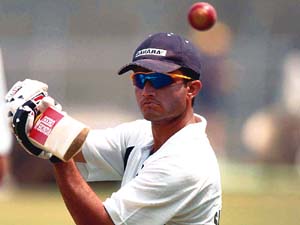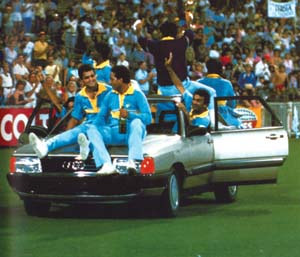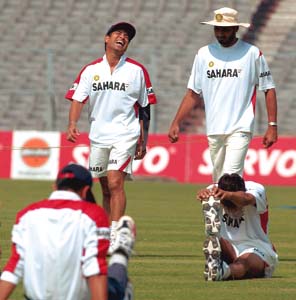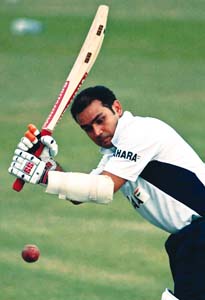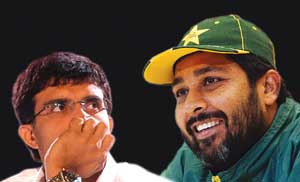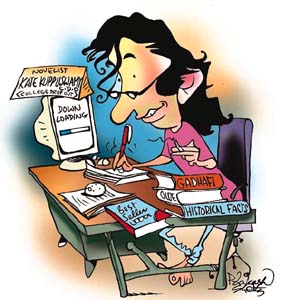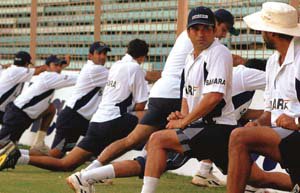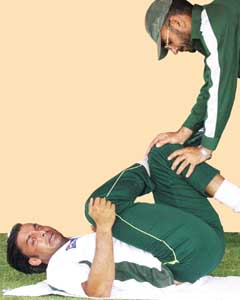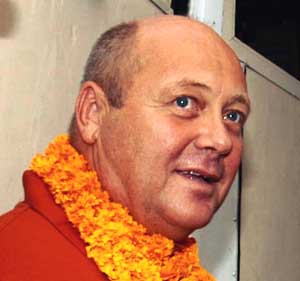It was not too long ago when they were the toast of the nation. But the party’s over and all that remains is a hangover. L Suresh peers through the fog…
By March 2003, they gave nine reasons why they should be called the number two team, behind Australia. By April 2004, they had rival captains despairing with nothing but footwear on their minds. While Steve Waugh was coming to terms with the fact that he was going to hang up his boots with neither the Final Frontier nor a home series win adding a feather to his tattered baggy green, Inzy was actually wishing that he were in Dada’s shoes. Words like think-tank, huddle and victory crept into the vocabulary of the Indian cricket fan as he finally figured out, with a huge sigh of relief, that he didn’t have to pull the curtains, bolt the door and get under the bed every time the Men in Blue clashed with Pakistan in a one dayer or played a test match abroad. And then the alarm rang.
A billion people woke up to reality and rubbed their eyes, more out of sheer disbelief than out of habit. The happenings in the next twelve months weren’t just Wes Craven’s nightmare, it was a nation’s. It took a bunch of individuals to come together and create a world-class team. And it took a team to come apart and leave these individuals stranded. Six men, who started as the Band of Brothers and ended up like a boy band – defunct and disjointed.
Sourav Ganguly – cometh the man, cometh the crisis
48 runs in five test innings and 31 in four one-dayers against Pakistan. 59 in three test innings against Australia.
He thinks he is just a match away from a big score. He thinks he doesn't deserve a place in the World XI. He thinks his future is up to the selectors. Despite his hundred for Glamorgan last week and his delayed entry into the MCC XI for the tsunami relief match, Sourav is doing a lot of thinking. The last time he was on a binary scoring format, India was on the threshold of a miracle – a win against the mighty Aussies. Hardly four years later, the captain finds himself pin coding the scorecard with a string of single digits. Add to this the controversy of a ban, the responsibility of a team going downhill and frequent injuries – when you’re captain, trouble doesn’t hunt in pairs, it stalks as foursomes.
Support, admiration, criticism, anger and now pity - Sourav's cosmic connection with the Indian cricket fan has seen it all. The God of the offside today stares at the word as if it were a football foul.
The road ahead for Dada might just be paved with problems. Ranbir Singh Mahendra is Dalmiya's man. So is Sourav. But there’s no love lost between the two. This could well be the sequel to Kuch Kuch Hota Hai - and as with the original, the hero who has it all might just be ‘Rahul’.
Irfan Pathan – a career on a reverse swing
0- 91 in 13.4 overs in the Videocon Cup. 6-410 in three tests and 0-67 in 8.2 overs in a one-dayer against Pakistan. 2-168 in two tests against Australia.
Long before the Indian Idol began, Kapil’s retirement launched a massive manhunt, with every trespasser being auditioned for the role of an all-rounder. In just 13 tests, Irfan has been dubbed India's next Kapil, found himself a bunny in Yousuf Youhana, been voted the Emerging Player of the Year by the ICC, has taken his first 10 wicket haul - and until recently, found himself torn between a side strain and poor form. (While the poor form remains, the side strain has been sidelined by a shoulder injury.)
It was a career that started like his lethal outswinger, with batsmen finding their chances of scoring going farther and farther away from them, with every passing series. And then began the reverse swing. If only that glorious moment in time when a swinging yorker crashed into Gilchrist's stumps in the 4th test at Sydney had stood still… Today, Pathan has learnt his most important lesson - in Indian cricket it's never lonely at the top, but you’re all alone when you're down and out.
Laxman – you miss some and no one misses you
54 in 6 test innings against Australia. 47 runs in 2 innings against South Africa. Dropped for recent one-dayers.
Cricketer of the year in 2002. A miss in the World Cup. Three tons in the VB Series in 2004. A miss in the one-dayers against Bangladesh and Pakistan. This has been a way of life with a man whose initials have always expanded to express a form that fluctuated from very, very special to very, very suspect.
In the middle of a deluge of runs by Sehwag, Dravid and by half the Pakistani team, a couple of 50s by Laxman seemed more like a puddle that lazily formed besides the pebble that never rolled. And though he would certainly like to be known by his 69 that helped us win the 4th test against Australia in Mumbai, he'll have to live with the ignominy of failure that saw him average nine in the remaining innings – a number that once used to remind him how close he was to a score of 290. Add to this his ‘poor fielding’ and it’s not surprising that of late, the closest Laxman has got to a one dayer has been by pulling his couch closer to the TV.
Parthiv Patel – when every dropped catch becomes a scoop
Last count - 19 Tests? 23 goofed chances? 176 byes? Lost count…
To begin your career at 17 and to have effectively played your last test at 19 – surely life can't be this cruel. Surely the Indian team can't be that talented.
With Dravid taking away his chances of keeping in the one dayers, Parthiv Babyface Patel found himself alternating between being victimised by marriage rackets and appearing in ads on Cartoon Network. As for tests, the Final Frontier series resulted with fate being hand in glove with his fumbles. Australia came in looking for a way to overcome The Wall, but found a gaping hole - right behind the stumps. So while Parthiv’s batting abilities got the media waxing eloquent, his keeping abilities waned. Equally ill at ease with both spin and pace, his cricketing career was kept alive as long as Sourav played the innings of his life – batting for his favourite wicket keeper.
Out of form wicket-keepers behave like goal keepers – they blame their defenders for slip-ups and are no longer seeing the ball like a football. Small wonder then that Parthiv got what he deserved - the golden boot.
Yuvraj – a story without an opening or a middle
47 runs in four test innings against Australia. 25 in two innings against New Zealand.
A highest score of 35 in six innings in the one-dayers against Pakistan.
His first one day innings - the ICC Champion’s Trophy in Kenya – saw him hammer the Aussies for 84 runs. His third test saw him score a glorious 112 of just 129 balls against Pakistan. After that, Yuvi got into the Madonna mode of "I wanna sing, I wanna dance, I wanna entertain" and ended up doing none of the above. A shuffle from middle order to opening has resulted in him watching matches from vantage positions in the ground – sitting on the other side of the ropes.
Nine runs in two matches in the ICC Champions trophy at an average of 4.5. Just 37 runs from three matches in the NatWest Series against England. The 2002 NatWest victory is now a thing of the past. Sadly enough, so seems to be Yuvraj's dominance in one dayers. The joke doing the rounds is that all one needs to do to take his wicket is to wear a t-shirt that says 'spinner'.
Aakash Chopra – when everything that can go wrong, does
186 off 8 innings in Australia. 51 runs in 3 innings in Pakistan. 15 runs in 4 innings at home against Australia
Chopra must be one of those players who, as kids, never believed in reading a book from cover to cover. That should explain his selective reading of everything under D in the coaching manual - defence, defiance and dedication. In the bargain, A for attack, B for boundaries and C for centuries got missed out. The away series at Australia and Pakistan had brought him accolades for his patient stay at the crease and gutsy display of facing aggressive fast bowling. But the Final Frontier series where he drew straws with Yuvraj to figure out who would open, proved to be his last straw.
In Australia, Chopra had a swash-buckling partner in Sehwag who would score 40 for every 10 runs he scored. The pair was then followed by class, form, grit and style – in the form of Dravid, Sachin, Sourav and Laxman. This was a jigaw with the pieces firmly interlocked and holding each other in place - until it came apart. And Chopra, until recently part of a pretty picture, now resembled a used postage stamp - too recent to be of value, too stamped upon to be in circulation again and too slow to compete with the neighbourhood FedEx.
With Greg Chappell voicing his support for the League of Beleaguered Players, it looks as if each of these stories is going to have a happy ending. A new coach, a new captain and possibly a new-look team – let’s hope someone out there rediscovers the joy of winning consistently. They say the best way to avoid a hangover is to stay drunk. And the Indian fan is just waiting to pop a bottle and celebrate. Wonder what the Indian team is waiting for?
